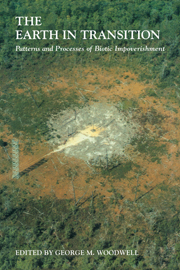Book contents
- Frontmatter
- Contents
- Preface
- Acknowledgments
- List of Contributors
- Part I Global Change and the Patterns of Impoverishment
- 1 The Earth under Stress: A Transition to Climatic Instability Raises Questions about Patterns of Impoverishment
- 2 The Experimental Impoverishment of Natural Communities: Effects of Ionizing Radiation on Plant Communities, 1961 – 1976
- 3 Air Pollution and Temperate Forests: Creeping Degradation
- 4 The Long-Term Effects of Air Pollutants on Lichen Communities in Europe and North America
- 5 Biotic Impoverishment in Northern Peatlands
- 6 Climatic Change and the Survival of Forest Species
- 7 The Atmosphere and the Future of the Biosphere: Points of Interactive Disturbance
- Part II Chronic Disturbance and Natural Ecosystems: Forests
- Part III Chronic Disturbance and Natural Ecosystems: Woodlands, Grasslands, and Tundra
- Part IV Chronic Disturbance and Natural Ecosystems: Aquatic and Emergent Ecosystems
- Part V Conclusion: Steps toward a World That Runs Itself
- Name Index
- Subject Index
6 - Climatic Change and the Survival of Forest Species
Published online by Cambridge University Press: 24 November 2009
- Frontmatter
- Contents
- Preface
- Acknowledgments
- List of Contributors
- Part I Global Change and the Patterns of Impoverishment
- 1 The Earth under Stress: A Transition to Climatic Instability Raises Questions about Patterns of Impoverishment
- 2 The Experimental Impoverishment of Natural Communities: Effects of Ionizing Radiation on Plant Communities, 1961 – 1976
- 3 Air Pollution and Temperate Forests: Creeping Degradation
- 4 The Long-Term Effects of Air Pollutants on Lichen Communities in Europe and North America
- 5 Biotic Impoverishment in Northern Peatlands
- 6 Climatic Change and the Survival of Forest Species
- 7 The Atmosphere and the Future of the Biosphere: Points of Interactive Disturbance
- Part II Chronic Disturbance and Natural Ecosystems: Forests
- Part III Chronic Disturbance and Natural Ecosystems: Woodlands, Grasslands, and Tundra
- Part IV Chronic Disturbance and Natural Ecosystems: Aquatic and Emergent Ecosystems
- Part V Conclusion: Steps toward a World That Runs Itself
- Name Index
- Subject Index
Summary
Editor's Note: Glacial advances and retreats over several hundreds of thousands of years have sorted and resorted the plant populations of the middle and high latitudes of eastern North America and have winnowed from those populations a flora of hardy survivors. The survivors among trees are almost uniquely singular species, unencumbered by dependence on other species, by the existence of a community, by a narrow dependence on edaphic perfection, or on special mechanisms for pollination or dispersal of seeds. The species of fir, spruce, birch, oak, poplar, hemlock, and pine can occur in almost any mixture in closed forests or in open woodlands, even on occasion in savannas, and on a range of habitats. To be sure, the species are not interchangeable, have different distributions and requirements and roles in succession, but, as wind-pollinated species (in contrast to tree species of the tropics that may depend on insects, birds, or mammals for pollination), they have few direct dependencies on other species that restrict them to any special community. We might go so far as to suggest that they are preadapted to climatic change as a result of selection by some of the most rapid climatic changes that we know of beyond the catastrophe of the Cretaceous/Tertiary boundary.
Margaret B. Davis, a distinguished scholar who has specialized in retrospective studies of vegetation, has addressed the challenge of estimating the rate of migration of one of these glacial survivors, Tsuga canadensis, under the climatic changes anticipated for the next decades.
- Type
- Chapter
- Information
- The Earth in TransitionPatterns and Processes of Biotic Impoverishment, pp. 99 - 110Publisher: Cambridge University PressPrint publication year: 1991



